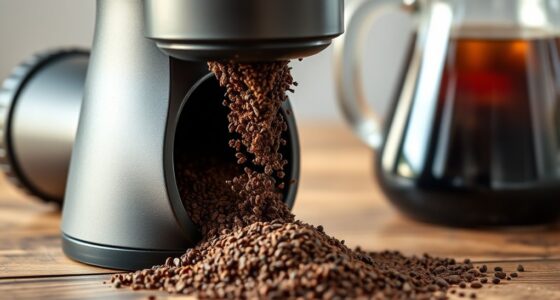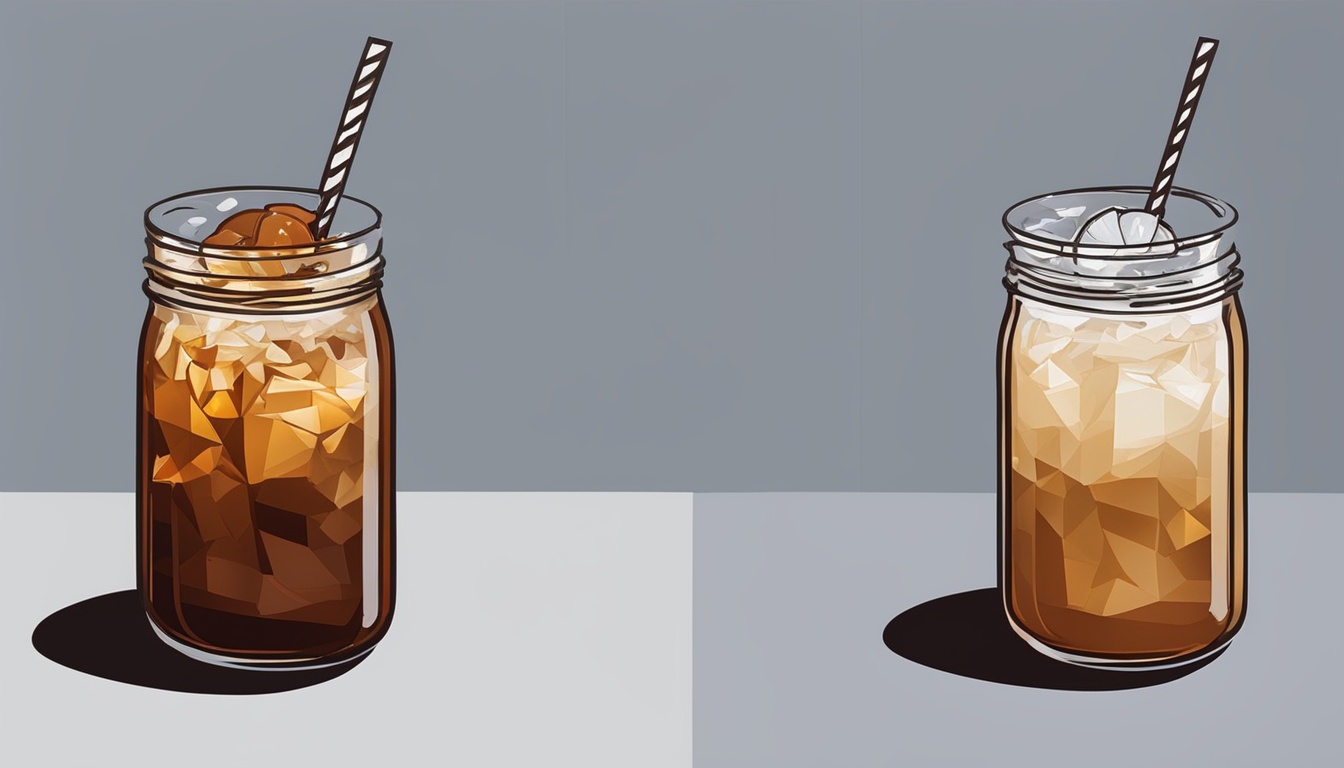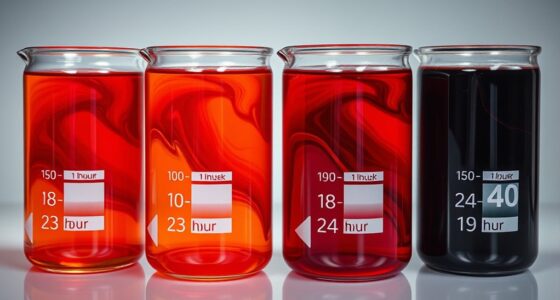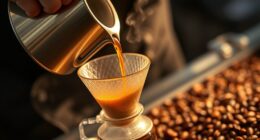To make your cold brew clear and grit-free, start with a multi-step filtration process. First, use a coarse filter to remove large coffee grounds. Then, follow with a paper or fine cloth filter to trap the tiny sediment that causes cloudiness. Layering filters ensures maximum clarity, enhancing both the appearance and taste. Proper filtration can turn a murky brew into a smooth, clean drink—if you want to discover more tips, keep exploring.
Key Takeaways
- Use layered filtration, starting with coarse filters and finishing with fine paper or cloth filters, for maximum clarity.
- Remove larger sediment with a fine mesh strainer before applying finer filtration methods.
- Employ paper filters or cheesecloths to trap tiny particles and achieve a clear, grit-free cold brew.
- Patience during each filtering stage ensures thorough removal of sediment and improves overall beverage clarity.
- Proper equipment selection and process steps help preserve flavor, oils, and create a smooth, visually appealing cold brew.

Have you ever wondered how clear water or pristine liquids are achieved? When it comes to making a smooth, grit-free cold brew, the secret lies in effective filtration. Coffee sediment, those tiny particles left behind after brewing, can cloud your drink and ruin its smooth texture. To prevent this, you need to understand the filtration methods that remove these unwanted particles and produce a crystal-clear cold brew.
Effective filtration removes coffee sediment for a crystal-clear, smooth cold brew.
The first step is recognizing what constitutes coffee sediment. These are the small, insoluble particles that don’t dissolve during brewing. If left unchecked, they settle at the bottom or float in your cold brew, giving it a murky appearance and gritty mouthfeel. To combat this, filtration methods come into play. There are several options, each suited to different preferences and equipment. Fine mesh strainers are great for removing larger coffee grounds, but they often leave behind finer particles that contribute to sediment. For a cleaner result, using a paper or metal filter is advised. Paper filters are highly effective because they trap even the smallest particles, resulting in a clear, smooth liquid. Metal filters, on the other hand, allow some oils and tiny particles through, which can add flavor but may not produce the same level of clarity.
Another effective filtration method involves cold brew cloth filters or cheesecloths. These are inexpensive and reusable options that catch finer particles that slip through standard filters. When you pour your cold brew through these cloths, you’re removing a significant amount of sediment, leading to a clearer drink. For those who want the utmost clarity, employing a multi-stage filtration process works best. Start with a coarse filter to remove bigger particles, then follow up with a paper filter or a fine cloth to catch the remaining sediment. This layered approach ensures your cold brew is as clear and grit-free as possible.
Using the right filtration method is vital because it directly impacts the taste and visual appeal of your cold brew. The clearer your drink, the more enjoyable it becomes—free from the gritty texture that can distract from its smoothness. Additionally, selecting the appropriate filtration methods can help preserve the delicate flavors and oils in your cold brew, enhancing its overall quality. The more precise and layered your filtration process, the better the final product will be. Remember, patience and precision during filtration make all the difference. By understanding the nature of coffee sediment and choosing appropriate filtration methods, you can consistently craft cold brew that’s not only flavorful but also visually stunning and perfectly clear.
Frequently Asked Questions
How Does Water Quality Affect Cold Brew Clarity?
Your water quality directly impacts cold brew clarity. High mineral content, especially excess calcium and magnesium, can cause cloudiness, making your brew look murky. Additionally, water with unbalanced pH levels can lead to extraction issues, resulting in a less clear, more sedimented cold brew. Using filtered water with balanced minerals and a neutral pH helps achieve a bright, clean appearance, ensuring your cold brew is smooth and visually appealing.
Can Alternative Filtration Methods Improve Grit Removal?
Yes, alternative filtration methods can enhance grit removal. You might try reusable filters or cheesecloth alternatives, which can trap finer particles more effectively than standard filters. Reusable filters are durable and eco-friendly, while cheesecloth alternatives like fine mesh screens or nut milk bags can ensure a cleaner, grit-free cold brew. Switching to these options helps you achieve better clarity and a smoother drinking experience.
What’s the Best Storage to Maintain Clarity Over Time?
You should store cold brew in airtight, opaque storage containers to maintain clarity and prevent light exposure that can degrade quality. Keep the temperature controlled, ideally between 36-40°F, to slow oxidation and preserve flavor. Regularly check your storage environment, ensuring it stays cool and consistent. Proper containers and temperature control help keep your cold brew clear and fresh over time, maintaining its grit-free consistency.
How Does Grind Size Influence Filtration Efficiency?
Did you know that using a consistent grind size improves filtration efficiency by up to 30%? When you focus on grind consistency, you control particle size better, which directly affects how smoothly the liquid passes through the filter. Finer grinds can slow filtration and increase sediment, while coarser grinds allow for quicker, cleaner extraction. Adjusting grind size to match your filtration method guarantees a clear, grit-free cold brew every time.
Are There Natural Additives That Enhance Clarity?
You can enhance clarity using natural clarifiers like finely ground chickpeas or volcanic ash, which help settle out particles. Herbal infusions such as chamomile or lemongrass also improve clarity by gently filtering impurities. These natural additives work without harsh chemicals, giving your cold brew a cleaner, smoother appearance. Experiment with small amounts to find the right balance, ensuring your cold brew remains flavorful while achieving that crisp, clear finish you desire.
Conclusion
By focusing on clarity and filtration, you create a cold brew that’s smooth, pure, and inviting. With each step, you refine your process, refine your taste, and refine your experience. Clarity enhances flavor, filtration removes grit, and patience transforms a simple brew into a perfect cup. Embrace the process, enjoy the journey, and savor the clarity that comes from your dedication. Because when you prioritize purity, you elevate every sip—making your cold brew truly exceptional.









